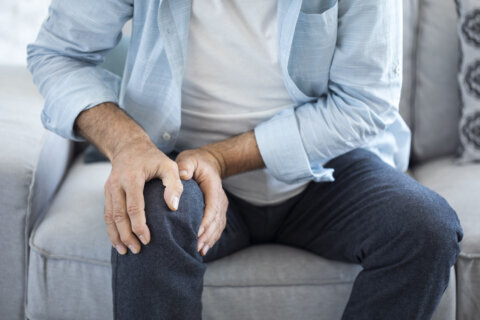This content is sponsored by MedStar Washington Hospital Center.
Varicose veins are tortuous, enlarged veins that typically occur in lower extremities. Varicose veins are extremely common and for many they are simply a cosmetic concern. However, for others, varicose veins can cause pain, discomfort, and more serious problems down the road.
There are minimally invasive treatments offered today that can improve patients’ symptoms and cosmetics, said Dr. Kryssy Maloni, a vascular surgeon at MedStar Heart & Vascular Institute. Taking steps early on may even help you minimize or avoid them altogether, Dr. Maloni added.
“While the condition isn’t generally harmful to your health, it can be uncomfortable and negatively impact your quality of life,” Dr. Maloni said. “With the minimally invasive treatments we offer today, there’s little risk in having them removed.”
Weakened veins cause varicose veins, and they can occur anywhere in the body, but they most common in the lower extremities. Venous blood travels against gravity, from the feet back to the heart. Muscles in the calf function to propel blood forward and valves within veins prevent backwards flow. Healthy valves close tightly, but weakened ones let blood flow backward, which puts extra pressure on the veins.
“That can create stretching and distortion, which leads to vein dilation and growth, and an appearance of purple, tortuous veins that bulge just beneath the skin’s surface,” Dr. Maloni said.
Approximately 23% of U.S. adults have varicose veins, according to the American Heart Association, and they are more common in women than men.
Common risks associated with varicose veins include having a family history of them, aging, pregnancy (especially with more than one child), long periods of standing on a regular basis and female gender. Additionally, a history of blood clots, or deep vein thrombosis (DVT), can also increase your risk, Dr. Maloni said.
Also, some people are born with a condition called May-Thurner syndrome that can lead to leg swelling and even varicosities. With this condition, an artery in the patient’s pelvis presses on an underlying vein carrying blood to your left leg, which results in downstream increase in venous pressure, swelling and dilated veins in the left leg only.
Many people find varicose veins to merely be a cosmetic concern, however there is potential for varicose veins to have more bothersome symptoms. Those symptoms include burning, bleeding, itching, aching pain and/or a feeling of heaviness in the legs and feet. There are times when minor blood clots develop. In severe cases, skin sores erupt.
Seeking treatment early can yield positive results for patients, Dr. Maloni said.
The common form of treatment, for patients who have appropriate anatomy and malfunction identified, is radiofrequency ablation – a minimally invasive technique where heat helps seal off the problematic vein. With this procedure, a numbing medication is injected, then a tiny needle is used to access the vein. A catheter is inserted into the vein and it uses radiofrequency to emit heat, which seals off the vein from the thigh to the knee. The veins downstream then regress over the next three months or so, Dr. Maloni said.
The procedure takes less than 30 minutes, requires no anesthesia or downtime and is highly effective with little risk, Dr. Maloni said.
“Most patients don’t need any further procedures and are happy with the long-term results,” she said.
MedStar Health also offers a newer procedure, VenaSeal. It is similar to radiofrequency ablation but, instead of using heat inside the vein, VenaSeal involves injecting a medical-grade adhesive to close it. With this treatment, there are fewer injections, which some patients prefer, Dr. Maloni said.
For much smaller varicose or spider veins, MedStar Health has sclerotherapy, which involves injecting a solution into the vein that causes it to collapse and fade away over a few weeks.
For extremely dilated veins, more complex treatments may be needed. A surgical phlebectomy may be recommended. That involves making small incisions over the affected veins and actually removing them one by one.
“While surgical phlebectomy is more complex and invasive, it’s also highly effective for advanced cases,” Dr. Maloni said.
There are ways for people to work toward prevention or worsening of varicose veins, Dr. Maloni said. Compression stockings are the best way to minimize varicose veins. These improve circulation and prevent distension and growth of varicose veins.
“I highly recommend them if you already have varicose veins or are at risk for developing them, such as with pregnancy, or a job requiring lots of time on your feet,” Dr. Maloni said. “… In order for them to be effective, they must be worn consistently, putting them on in the morning when you get dressed and taking them off when you go to bed at night.”
There are other steps you can take to help prevent varicose veins as well. If you sit for long periods of time, try to elevate your legs above the level of your heart when you can and walk regularly to help stimulate the muscles and keep blood flowing. And skip the quick-fix supplements you may see on TV or online. “I recommend avoiding herbs and supplements you see advertised, as there’s no good evidence that they can prevent or help varicosities,” Dr. Maloni said.
It is beneficial to seek medical treatment before varicose veins become problematic, Dr. Maloni said.
“While medical treatment for varicose veins isn’t always a must, varicosities do tend to worsen over time,” she said. “Coming in early for an ultrasound evaluation and a conversation about prevention and treatment options is ideal.”
MedStar Health’s multidisciplinary team works together to make sure patients have the most comprehensive care, Dr. Maloni said.
“We address the full range of vascular problems, so we are able to look for the obvious causes of varicose veins as well as the more complex.”
Read more in a blog post on MedStar Washington Hospital Center’s website.







